Please Note:
Firefox and some other search engines are not suitable
– Use “Internet Explorer” for this page to load perfectly!

Click the logo above to reach the Cruise-Australia
FrontPage for News Updates & “Ship of the Month”
With
Reuben Goossens
Maritime
Historian, Cruise‘n’Ship Reviewer, Author & Lecturer
Please
Note: All ssmaritime and my
other related ssmaritime sites are 100% non-commercial and privately owned
sites. Be assured that I am NOT associated with any cruise or shipping
companies or travel/cruise agencies or any other organisations! The author has
been in the passenger shipping industry since May 1960 and is now semi-retired,
but continues to write article on classic liners and cruise ships in order to
better to inform cruise and ship enthusiasts for their pleasure!
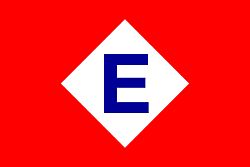
The
First Series of the Much Loved “Four Aces”
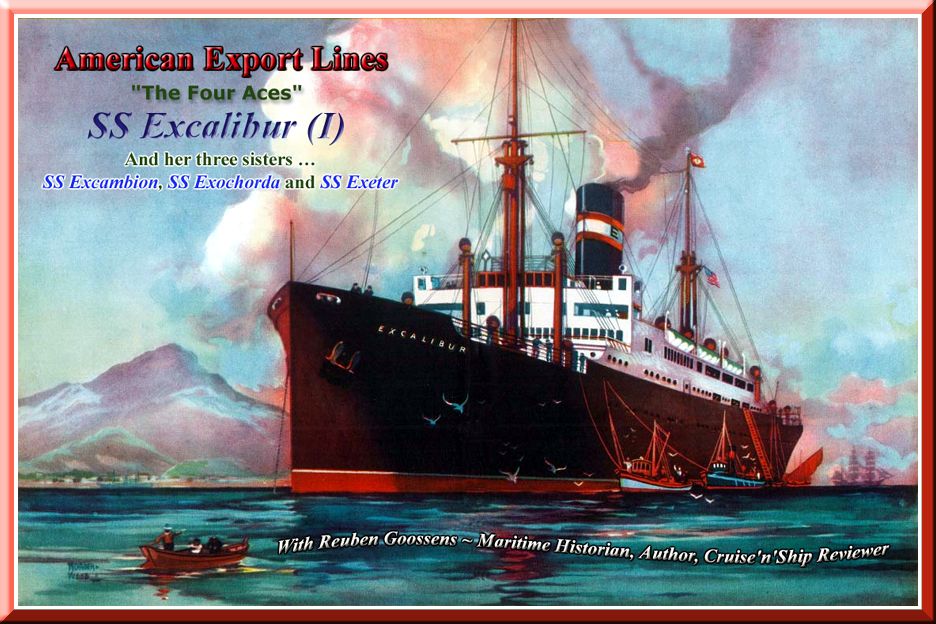
The
American Export Lines (AEL) ordered the New York Shipbuilding Company of Camden, New Jersey, a special contract
#394, to build four liners commencing in 1929 with the last ship to be
completed by1931 and commenced sailing by 1932.
All four ships were designed by
George G. Sharp, Inc., and the SS Excalibur was the very first-generation of
what became the famous “Four Aces.” Her sister ships that soon
followed her were the SS Excambion (I) in 1931, SS Exochorda (I) 1931, and SS Exeter (I) also in 1931.
Excalibur’s keel was laid on November 4,
1929 and she was launched on August 5, 1930. She was delivered on December 18,
1930. AEL placed the 4 Aces in service between the USA and the Mediterranean, and with the ultimate of
comforts and fittings. On board passengers could be assured that the ship would
offering luxury 43 day cruises in the sublime of luxury, sailing the Atlantic
and the warm waters of the Mediterranean!
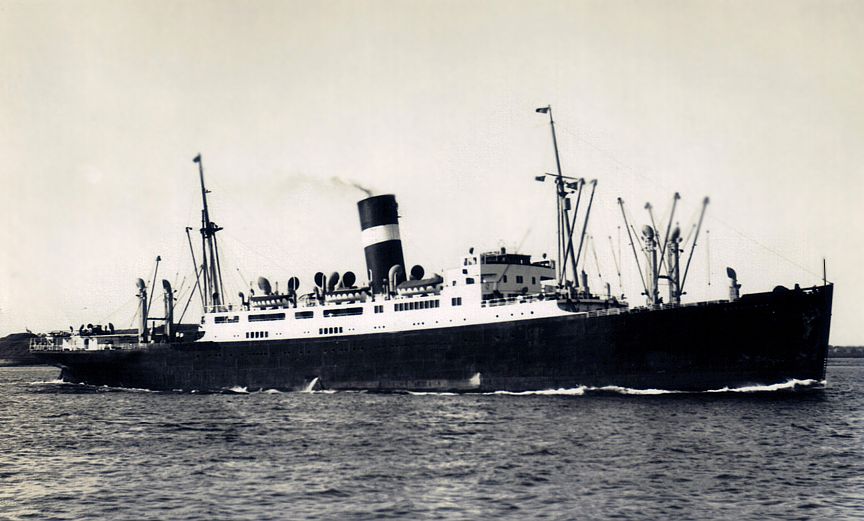
The
SS Excalibur (1) was an unimpressive looking liner, but internally she was as
good
and luxurious as any one of
the great Trans Atlantic liners of the 1930s to 1950s, etc!
Photograph
by R.T. Hildebrand
– Rich
Turnwald Collection
Every stateroom
aboard the SS Excalibur and her sisters were noted for having private bathrooms
as well as being superbly furnished in the most elegant of furnishings and
bedding. Staterooms were located on Promenade deck and one deck down on Upper
deck, where staterooms also featured a separate sitting room. This ship offered
all the luxury you could possibly want, and we need to remember that this was a
relatively small ship at just 9,359 GRT (gross registered tons) passenger cargo
liner, and not one of the grand Trans Atlantic liners, yet she and her sisters
offered a boutique style of service, offering the finest style on offer for her
days!
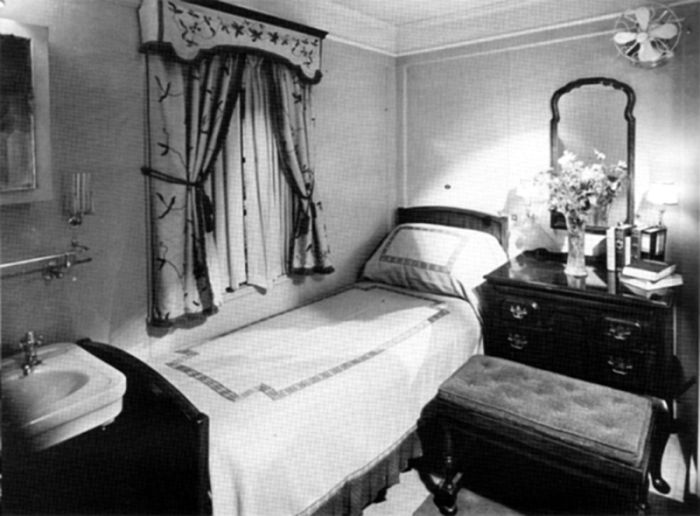
A
single bed Stateroom with a private Bathroom, but the wash basin in these rooms
were in the cabin
Photograph
from the author’s collection
Her Lounges and bar
were all simple elegance beyond compare. Forward on Promenade deck was the
spacious Main Lounge featuring a centred high domed ceiling running the length
of the room, the floor carpeted in blue, the walls clad in beige timbers and
the furnishings comprised of sofas and various styles of chairs in aqua,
orange, red, blue and patterned upholsteries. Tables where all made of fine
dark timbers. Aft from the Main Lounge there were mostly staterooms until
reaching the ships Main Stairwell semi aft of the ship, which was followed by
the elegant Smoke Room that was also domed and the venue and the lower walls
were timber clad some eight feet high with timber embellishments above. The
Smoke Room Bar was located aft of the venue and the bar was semi circular and
clad in all timber. The floor was in dark tiles that were of a similar colour
to the walls. As were the timber tables. Chairs were upholstered with green
leather, thus this venue was designed to be very much like a typical
men’s club. Aft of the Smoke Room was a stairwell followed by the
delightful Country Club Veranda Caf? that overlooked the aft decks. This venue
was more like the typical “Winter Garden” having teak decking,
palms everywhere, rattan chairs to ensure the tropical feel and tables always
clad with tablecloths.; The windows on the sides and aft could be opened for
cool breezes, thus this was an ideal place for a drink, or morning tea or
coffee. There were also comfortable sofas with deep cushions in red for those
who would just love to sit and read in this delightful atmosphere!
Down on Upper (A) Deck the main public venue
was around located towards the mid to aft of the ship at the Main Stairwell and
the upper level that looked down into the Dinning Room below on B Deck. The
balustrade that surrounded the spacious well above the Dinning Room included a
series of superb white columns as well a beautiful wrought iron balustrade.
Around the this beautiful area there was lounge as well as a reading and
writing facility, all part of the luxury and glamour of these superb ships!
Below, the Dinning Room was
without doubt the sublime in beauty. This light and bright venue, being two
decks in height in the centre, and due to this made this room one of the most
elegant public rooms afloat at the time! It featured a neoclassical design with
eight solid round columns all decorated with floral crowns atop on the top
level, and a simpler decoration on the lower level. Everything on the lower and
upper levels was glistening white, yet the walls were of a fine painted
woodwork, and then there was that break in all that white with the black detail
in the metal work on the mezzanine floor balustrade. Of course the tables in
the Dinning Room were always set with fine crystal, silver and the best quality
bone china and the freshest linens!
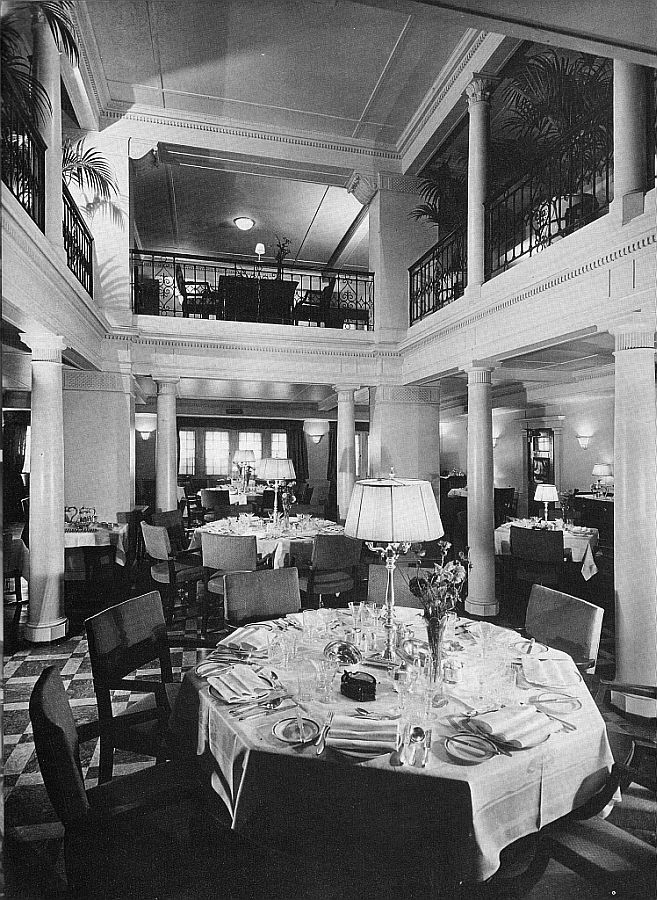
The
luxurious two story high Dinning Room, although the top level was a lounge area
Photograph
from the author’s collection
The ship had a long
and a spacious glass enclosed Promenade Deck, which was just wonderful for the
cooler days on the Atlantic
with ample wooden deckchairs and stewards would always be at hand with a pure
woollen blanket, a hot drink or whatever one would desire!
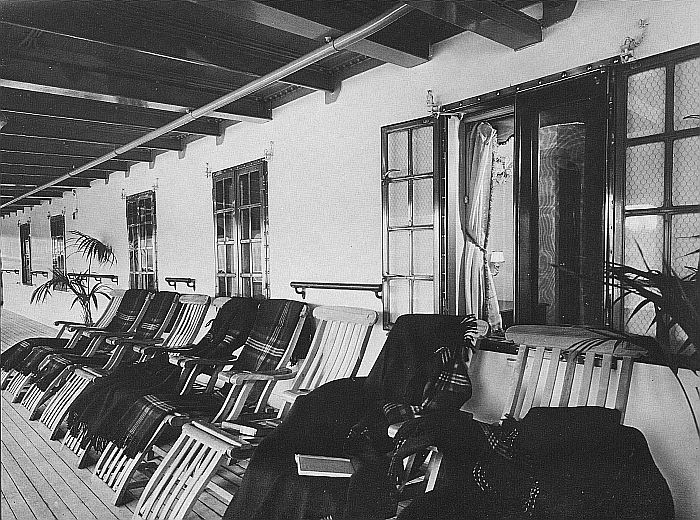
Promenade
deck ready with cosy blankets, but palms give it a tropical feel as passengers
head for the Mediterranean
Photograph
from the author’s collection
Please
Note: There is a Colour Interior Photo Album Down the Page!
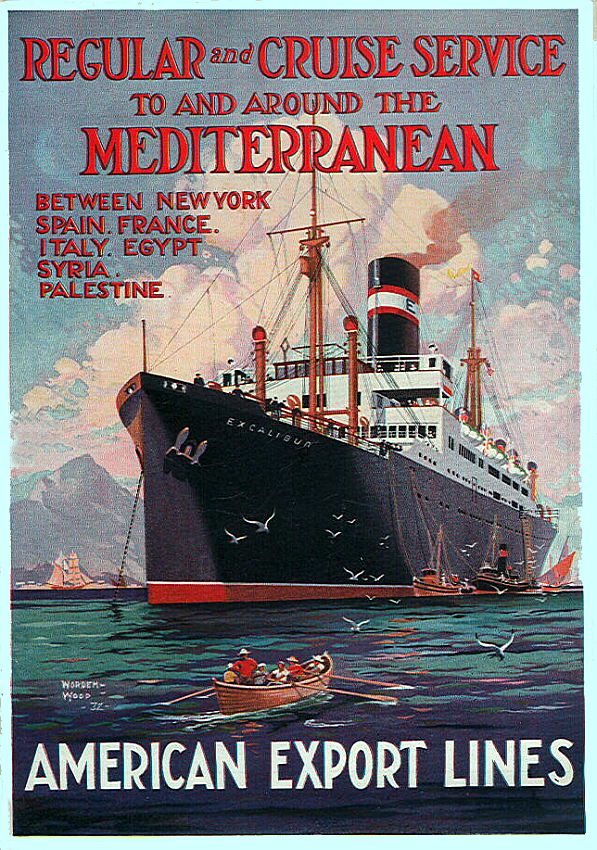
A poster promoting the SS
Excalibur as her sisters had not entered service as yet
Form the author’s private collection
The Excalibur was ready for her maiden voyage
on January 24, 1931 and departed New
York sailing across the Atlantic for Marseilles, then Naples, Alexandria,
Jaffa, Haifa, Beirut,
Alexandria, Naples, Leghorn,
Genoa, Marseilles and back to New York.
She continued on this route until she departed Genoa for New York, sailing via Alexandria and Lisbon.
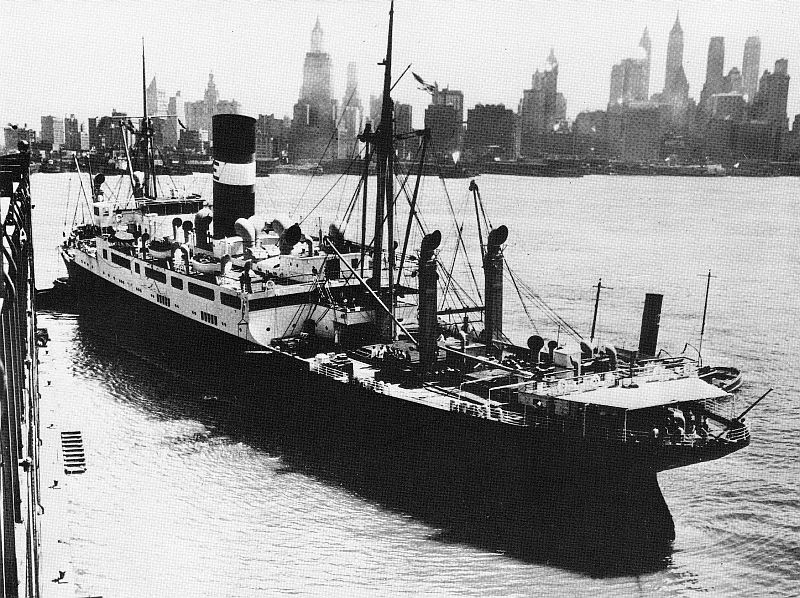
The
Excalibur is seen at the “American Export Lines Terminal” in Jersey City, - New York
Harbour,
but a wonderful view of her stern
Photographer
unknown - Please see photo notes at bottom of page!
During
her entire career the Excalibur (I) delivered a great deal of cargo, mail,
passengers the vast majority of them being American’s on round voyages
from the “American Export Lines Terminal” to various ports in the
Mediterranean and the service had been a wonderful success! But now we had
entered the war years in Europe
and a new schedule was required.
On July 18, 1940 The Excalibur departed
sailing on the New York to Lisbon service, and it would be during one of these
voyages that the Duke and Duchess of Windsor boarded her in Lisbon as they were
being evacuated, and special arrangements had been made for the ship to call
into Bermuda for the Royal couple to disembark there. The ship continued this
service for around a year, until Uncle Sam needed her and all her sisters!
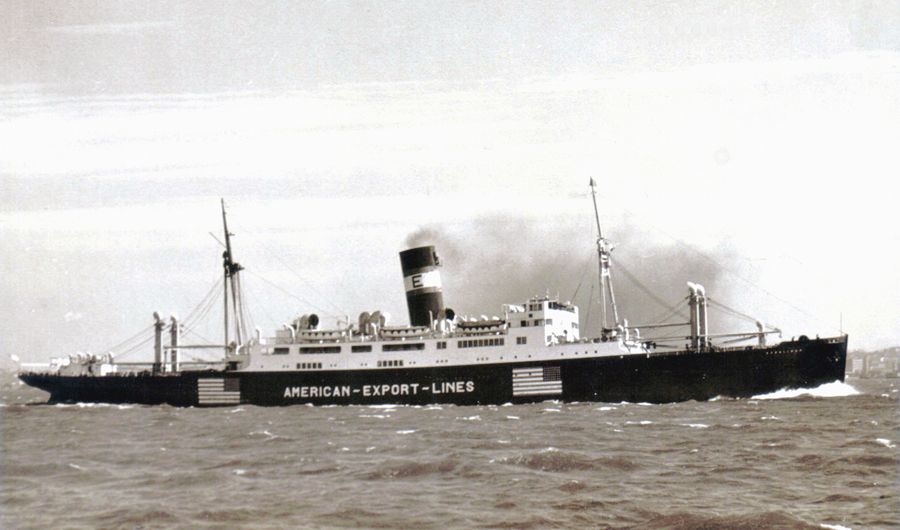
This
photograph was taken during the early war years denoting that she was a neutral
ship of the USA,
whilst on the Lisbon service
Photograph
by Roger
Scozzafava – From
the Rich Turnwald collection
Her Three
Identical Sisters:
SS
Excambion (I)
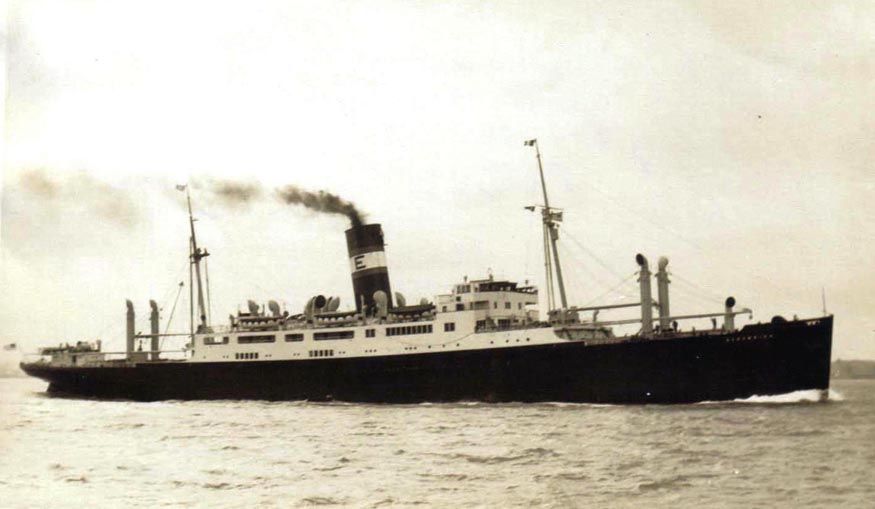
SS
Excambion
(I) commenced sailing in 1931
The
SS
Excambion became the
troopship USS John Penn, but she was sunk by a Japanese torpedo bomber off Guadalcanal on 13 August 1943
Photograph
by Roger
Scozzafava – From
the Rich Turnwald collection
SS
Exochorda (I)
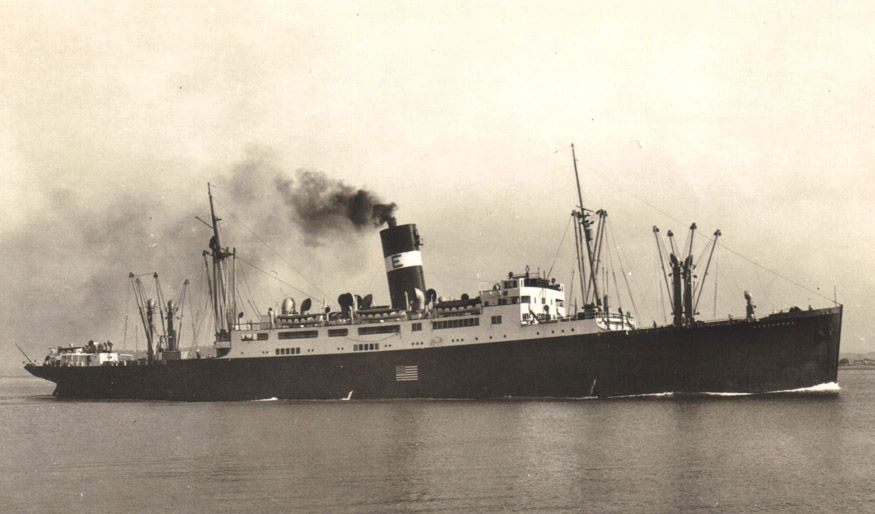
SS
Exochorda (I) also
commenced sailing in 1931
During
the War she was named USS Harry Lee and survived. In 1948 she was sold to Turkey
and became the very popular classic SS Tarsus
Photograph
by Loren Graham
– From the Rich
Turnwald Collection
A Short History regarding
the SS
Exochorda / SS Tarsus:
After the war the USS Harry Lee arrived
back in the USA
on February 9, 1946, and she was decommissioned at the Brooklyn Navy Yard May
9, 1946. She was placed in the “Reserve Fleet,” that really means
she had been shutdown and was a dead ship, thus “mothballed” for there
was no further use for her, and she was no longer required by the
“American Export Lines” considering her condition after the war as
well as her age, and as the company by now had acquired a more modern quartet
of ships, being the new “Four Aces” to take the place of their
three lost ships, and they desired to keep the four original names in tact with
four identical sister ships!
Then in April 1948 the ex SS Exochorda was sold to the
Turkish State Maritime Line who gave her an extensive refit that saw various
changes that were visible externally, her aft two king posts were removed, and
her promenade deck completely rearranged, with new floor to ceiling windows in
the forward section and now the decks aft were open. In addition additional
lifeboats were added as the ship would now accommodate more passengers, such
as; 189 First Class, 66 Second Class and 210 Third Class, who were housed in
large style dormitories.
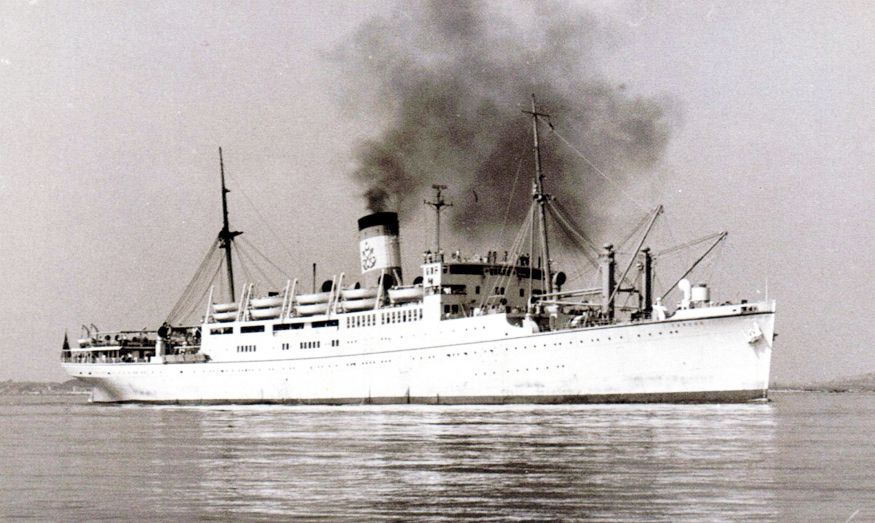
Turkish
State
Maritime Line – SS Tarsus
Photograph
from the author’s collection
The
SS Tarsus at the time was Turkey’s
largest passenger liner and became one of the counties most popular ships!
However, due to a tragic accident involving a blazing oil tanker that drifted
towards her whilst she was at Bosphorus (Istanbul) Turkey,
she was completely destroyed by fire in December 1960. She had been the
innocent bystander, but this sadly beautiful and once glamorous luxury ship was
a total loss. She was scrapped in that same year.
SS
Exeter (I)
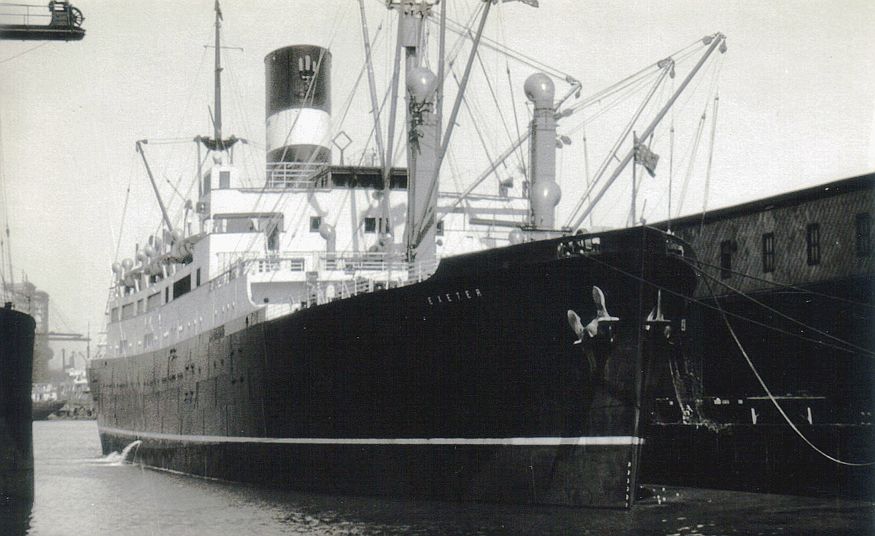
And
the last of the “Four Aces” the SS Exeter
(I) also completed in 1931
She
became the USS Edward Rutledge in 1941, but sadly she was also torpedoed and
sunk
off Casablanca
in November 1942 much at the same time as Excalibur
Photograph
by John
O’Leary – From the Rich Turnwald
collection
Back to the
Excalibur:
For interest, from 1940 through to 1941 the
Excalibur made many round voyages between Portugal and the USA and she was
instrumental in the success of the war-time Emergency Rescue Committee;
transporting thousands of refugees from Nazi Europe to freedom in the United
States.
USS Joseph Hewes - AP-50:
With the outbreak of the World
War II the SS Excalibur was appropriated by the U.S. Navy and refitted to
become a troopship renamed the USS Joseph Hewes
(AP-50). Besides her external paintwork, she was fitted with a pole radar mast
atop the bridge and two forward 3”/50 guns are on the main deck behind
bulwarks.
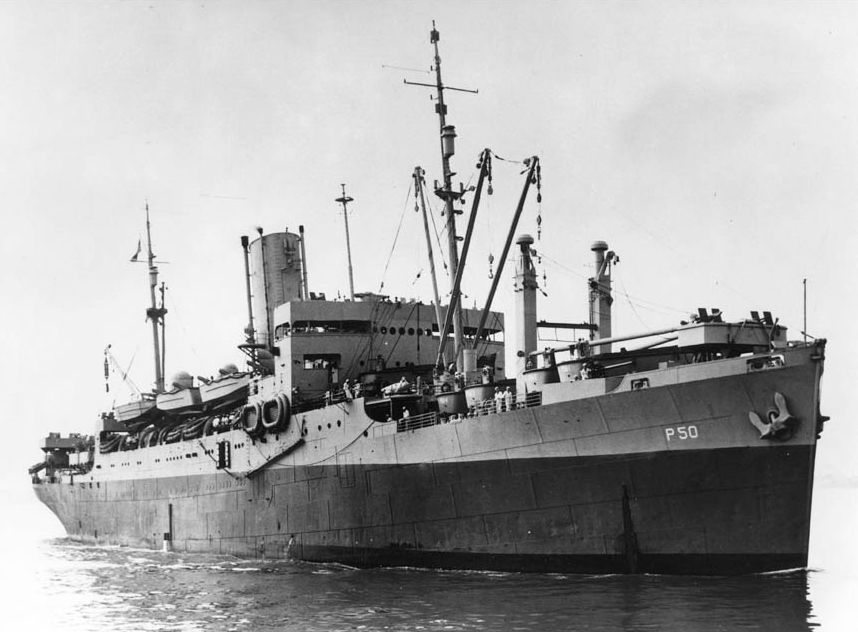
The
USS Joseph Hewes - AP-50 shown here as she heads off
for War duties, note her guns forward and her radar pole on top of the bridge
Photographer
unknown - Please see photo notes at bottom of page!
The Joseph
Hewes operated her
duties well, but on the morning of November 8, 1942, she completed landing her troops
in Morocco
especially for “Operation Torch” the invasion of North Africa and she duly departed. However,
around twelve hours later, the USS Joseph Hewes (ex
SS Excalibur) was hit by a torpedo from the German submarine U-173. Regardless
of the many heroic efforts by the ships captain and her crew, the ship
tragically went down in around forty-two minutes. Sadly the captain and some
100 sailors went down with the ship.
It is amazing that three
of the much loved “Four Aces” had been lost during the war, for
only the SS Exochorda survived and was sold to Turkey
to become the charming all white SS Tarsus, but she also met up with a tragic
end, and not of her own making, but that of a oil tanker that drifted against
her which was on fire in 1960. These were some of the most beautiful and
luxurious combo liners ever, externally, they certainly did not look much, but
once you stepped on board, it was all glamour and ships full of charm!
Colour Interior Photo Album
For your enjoyment I
present a series of images that depict the interiors of all the “Four
Aces.” These originate from an old brochure kindly provided by Bjorn
Larson, sadly the quality may not be so out
standing, but I have attempted to improve them be it but a little. But I am
sure that they will provide you with an idea of the wonderful facilities of the
days when these four combo liners sailed on their 42 day
voyages and I can just see myself on board - for just a moment in time!
Promenade
Deck
Commencing
from forward to aft
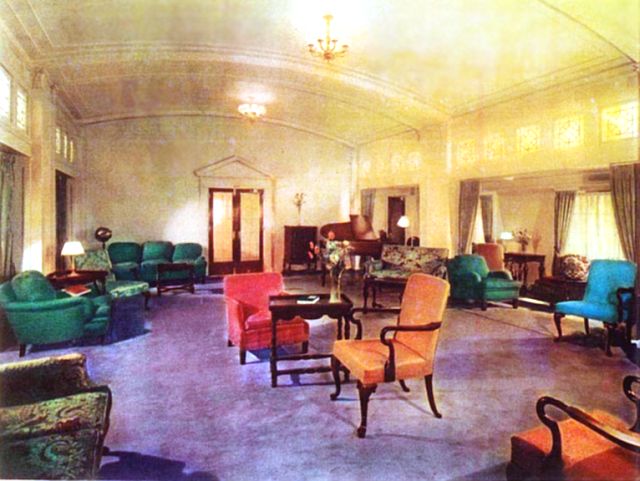
The
Main Lounge – looking aft to the main entrance
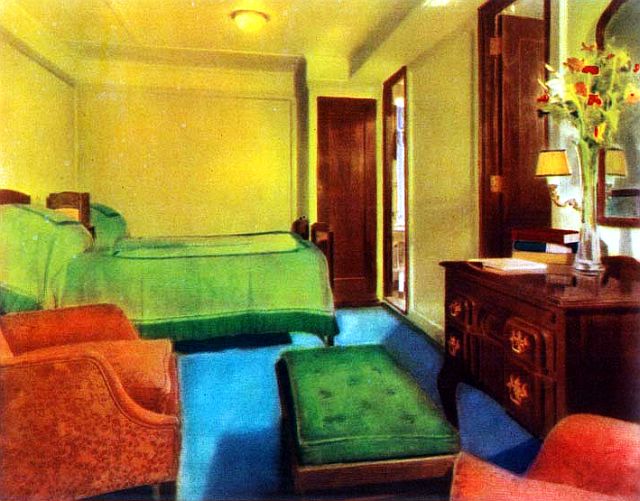
A
Promenade deck twin bedded stateroom with a delightful lounge area and a full
sized bathroom
These
are located between the Main Lobby and the Smoke Room
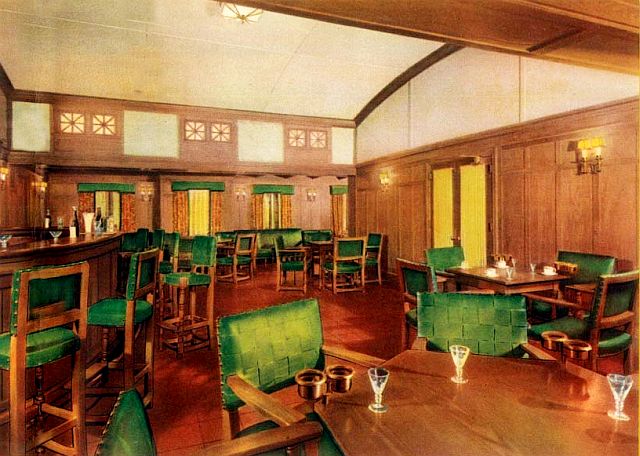
Further
aft was the Smoke Room and Bar had that dark timber
feel, which was so typical of the day. A typical man’s room
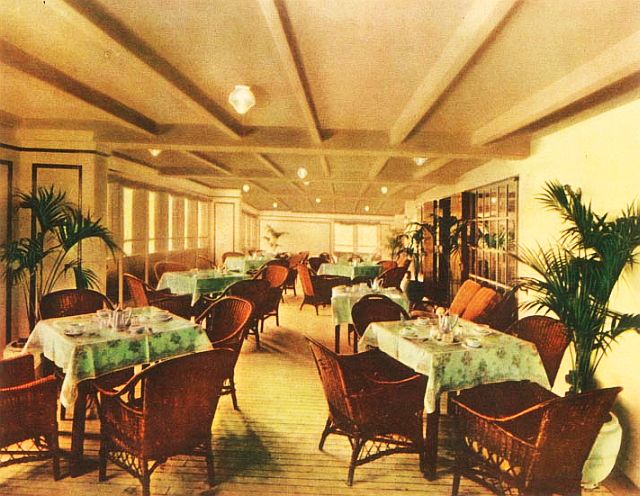
Far
Aft was the Country Club Veranda Caf?
Upper
(A) Deck
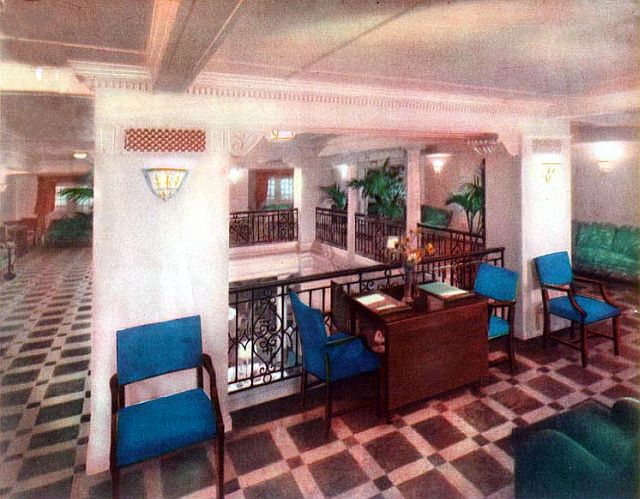
The
Upper Stairwell, Lobby and Lounge and writing and reading area
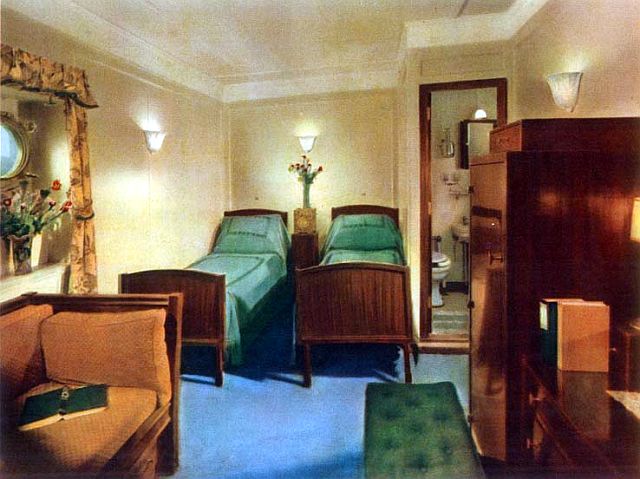
This
is one of only two special Staterooms on each side of the ship that had their
own lounge, but also shared a Veranda with another stateroom
The
veranda was located in the centre and there was a door from each stateroom for
them to share this delightful area with big windows
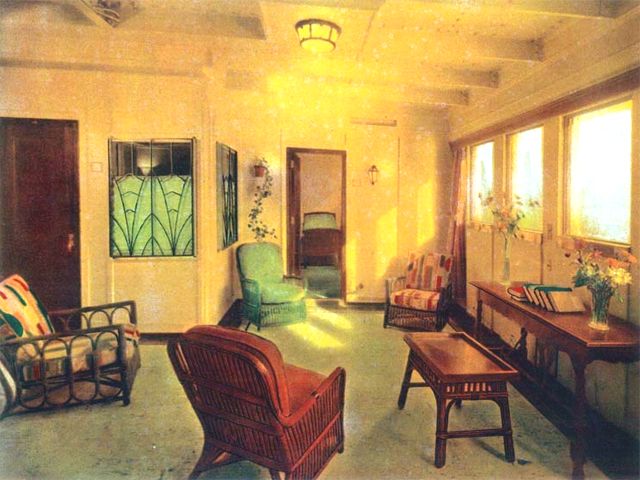
The
special veranda shared by the two special de-Luxe staterooms on each side of
the ship!
B Deck
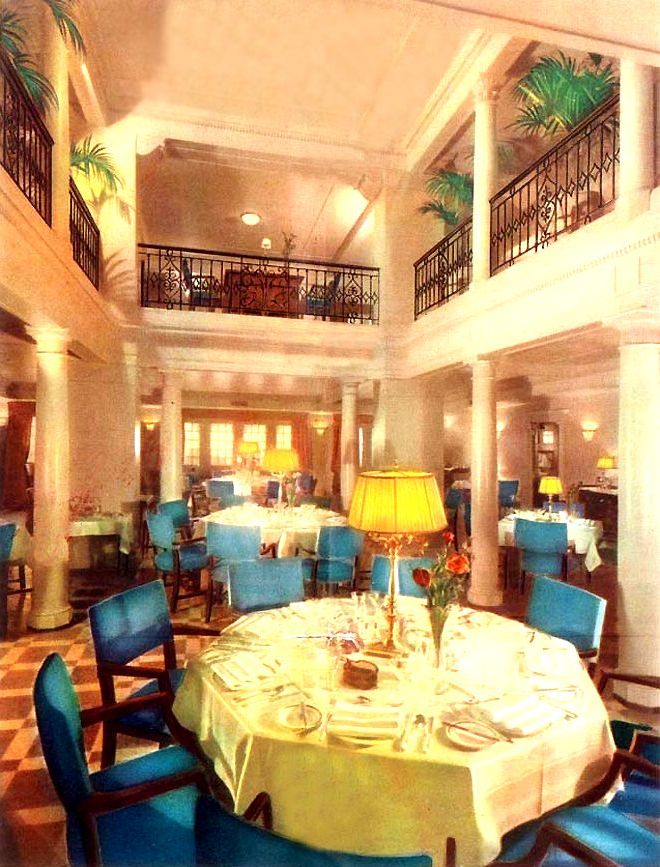
The
Dinning Room as already described earlier,
but here we see it in its full glory!
I wish
to thank Bjorn Larsen of Maritime Timetables
for the colour images on this page!
He is a remarkable source for images and it is much appreciated that he
allows me to use these!
Visit
his site at: www.timetableimages.com/maritime/index.htm
- Thank you also to all contributors of images!
Details
& Specifications – Passenger – Cargo Liner SS Excalibur (& spec’s for her 3 sisters)
Built by:????????????????????? York Shipbuilding Company
of Camden.
Launched:??????????????????? August 5, 1930.
Maiden voyage:???????????? January
24, 1931.
Length:??????????????????????? 450ft
– 217.39 Meters.
Breadth:????????????????????? 62ft
– 19 Meters.
Draught:????????????????????? 26ft
– 7.9 Meters.
Gross Registered Tonnage: 9,359 GRT.
Main Engines:?????????????? Steam S.R.
Geared Turbines.
Propellers:?????????????????? 1.
Speed:???????????????????????? 16 knots.
Passengers:????????????????? 125
First.
?????????????????????????????????
The
SS
Excalibur II
(built as the USS Dutchess) was 9,644 GRT, and 473ft
long, with a beam of 66ft, and a draught of 27.9ft. She was one of a quartet of
post-war almost identical sister ships placed into service by American Export Lines.
These four sister ships, SS Excalibur, Excambion,
Exeter and Exochorda, were the replacements for
series One of “Four Aces,” and these four ships took on the same
title, as series Two of the “Four Aces.”
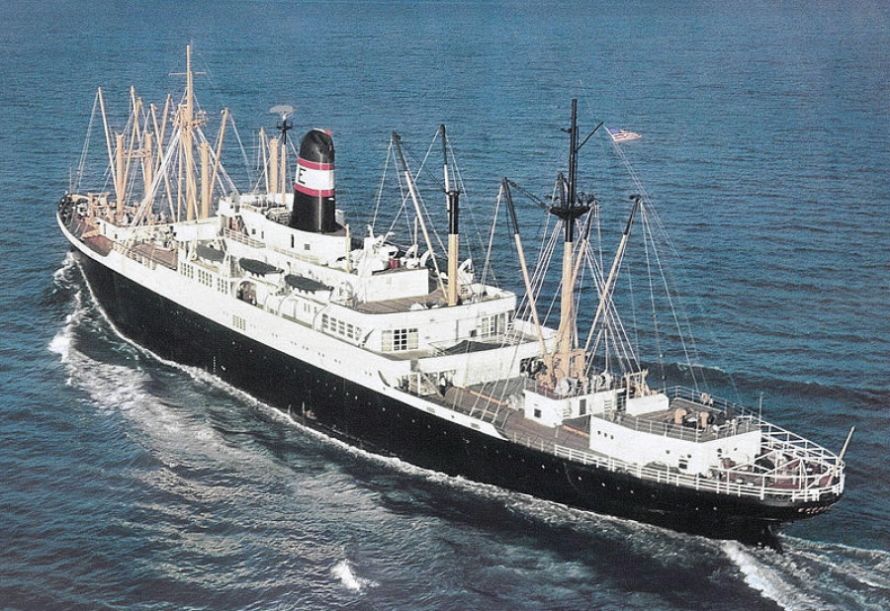
SS
Excalibur II
was the third of a series of almost identical ships
Photograph
provided by Bjorn
Larson's maritime timetables - www.timetableimages.com/maritime/index.htm
All four ships were originally
built in 1944/45 as US Navy ships, but they were all converted and delivered to
American Export Lines in 1948. They operated between New York and the Mediterranean, and
accommodated 124 First Class passengers, and departed from Hoboken, New Jersey (New York harbour) sailing to Cadiz, Barcelona,
Marseille, Naples,
Beirut, Alexandria, Piraeus, Naples,
Marseille, Genoa,
Leghorn and Barcelona back to New Jersey.
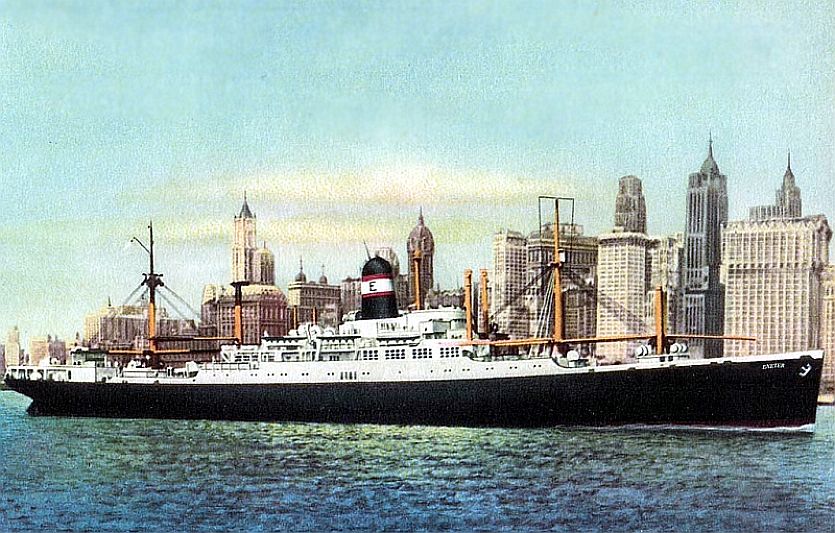
The SS
Exeter II
is seen in New York Harbour
From the author’s private collection
SS Exochorda
and Excambion were laid up in 1960, being sold in
1967 and 1965 respectively. The remaining two ships SS Excalibur and the Exeter
were both sold in 1965 to the Asian shipping giant C.Y.
Tung's Oriental Overseas Line and were renamed the
SS Oriental Jade and Oriental Pearl respectively. Some nine years later, the
Oriental Jade and Oriental Pearl were scrapped in 1974.
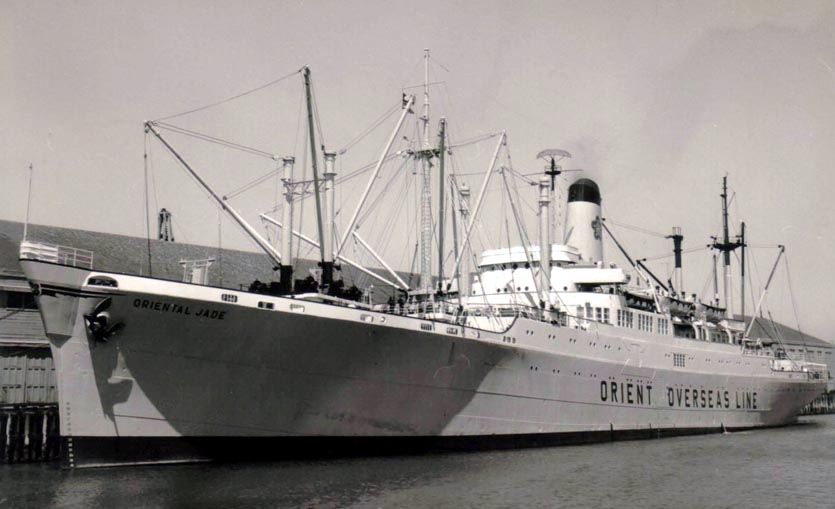
SS Oriental Jade seen with an
extension to the top of her bow that was added after her refit
Photograph by A.
Duncan – From the Rich
Turnwald Collection
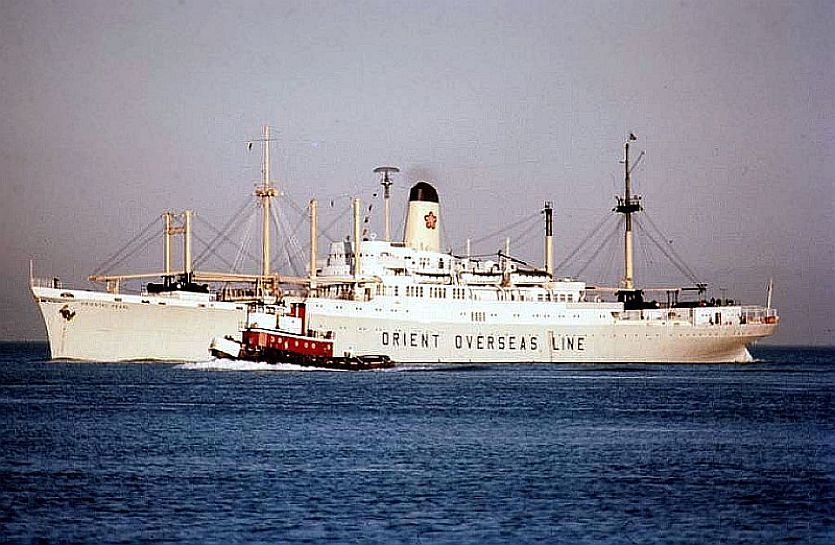
A fine photograph in colour of the
SS Oriental Pearl
Author’s private collection
Memories of the
Original “Four Aces”
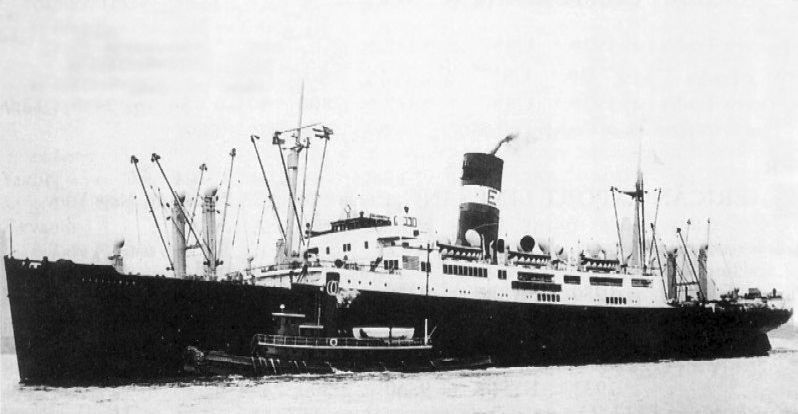
A very old print of one of the
“Four Aces” scanned some time ago
Who would have thought that a ship
such as this would be as luxurious inside?
Yet they were simply the very best
ships of the day and recorded in books as being
ships with the “Most Glamorous
Interiors!”
From the author’s collection
****************************************
Use
the Back button on your browser or Close the Page to return to the previous
page
or go to our INDEX
ssMaritime.com & ssMaritime.net
Where
the ships of the past make history & the 1914 built MV Doulos Story
Also
visit my
Save
The Classic Liners Campaign
Photographs on ssmaritime and associate pages are by the author or from the
author’s private collection. In addition there are some images that have
been provided by Shipping Companies and private photographers or collectors.
Credit is given to all contributors. However, there are some photographs
provided to me without details regarding the photographer/owner concerned. I
hereby invite if owners of these images would be so kind to make them-selves known
to me (my email address may be found on www.ssmaritime.com only), in order that due
credit may be given.
This
notice covers all pages, although, and I have done
my best to ensure that all photographs are duly credited and that this notice
is displaced on each page, that is, when a page is updated!
ssMaritime is owned &
? Copyright by Reuben Goossens - All Rights Reserved



























